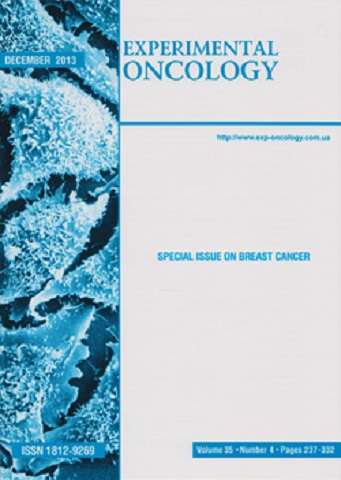CLINICAL CASE OF NON-TYPICAL METASTASIS OF NEUROENDOCRINE LUNG CARCINOMA TO THE VASCULAR MEMBRANE OF THE EYE
DOI:
https://doi.org/10.32471/exp-oncology.2312-8852.vol-44-no-2.17969Keywords:
immunohistochemistry, lung neuroendocrine carcinoma, morphological diagnostics, ocular metastasisAbstract
Background: Metastases in eye structures are rare (1–5% cases at systemic spread of different malignancies, mainly breast and lung cancers). The prognosis is poor. The overall survival usually does not exceed 12 or even 6 months. If metastases are found in the choroid membrane, the probability that the patient has multiple metastatic lesions of other organs increases significantly. Lung neuroendocrine neoplasms are rare (1–2% of all malignancies in adults), but mainly aggressive tumors. They are characterized by “blurred”, nonspecific clinical symptoms, the correct diagnosis is delayed seriously, and distant metastases are seen in more than 40% of patients (usually in chest structures, liver, bones, brain, and adrenal glands; metastasis to vascular membrane of the eye ranks the 6th place). Case report: Own clinical observation of a male patient with rare metastasis of lung neuroendocrine carcinoma to the choroid of the left eye is presented. The disease is manifested by an ocular metastasis, which was initially considered an embryonic tumor. Other metastatic lesions (hilar lymph nodes, liver, soft tissues) were detected on computed tomography a little bit later. The diagnostic algorithm using routine histological examination and immunohistochemistry, including detection of neuroendocrine markers (chromogranin A, synaptophysin), cytokeratin 7 and Ki-67 expression in primary and metastatic tumors is described.
References
Hendifar AE, Marchevsky AM, Tuli R. Neuroendocrine tumors of the lung: current challenges and advances in the diagnosis and management of well-differentiated disease. J Thor Oncol 2017; 12: 425–36. https://doi.org/10.1016/j.jtho.2016.11.2222
Cives M, Strosberg JR. Gastroenteropancreatic neuroendocrine tumors. CA Cancer J Clin 2018; 68: 471–87. https://doi.org/10.3322/caac.21493.
Oronsky B, Ma PC, Morgensztern D, et al. Nothing but NET: a review of neuroendocrine tumors and carcinomas. Neoplasia 2017; 19: 991–1002. https://doi.org/10.1016/j.neo.2017.09.002
Dasari A, Shen C, Halperin D, et al. Trends in the incidence, prevalence, and survival outcomes in patients with neuroendocrine tin the United States. JAMA Oncol 2017; 3: 1335–42. https://doi.org/10.1001/jamaoncol.2017.0589
Reed CT, Duma N, Halfdanarson T, et al. Primary neuroendocrine carcinoma of the brain. BMJ Case Rep 2019; 12: e230582. https://doi.org/10.1136/bcr-2019-230582
Ciobanu OA, Martin S, Fica S. Perspectives on the diagnostic, predictive and prognostic markers of neuroendocrine neoplasms (Review). Exp Ther Med 2021; 22: 1479. https://doi.org/10.3892/etm.2021.10914
Gosain R, Mukherjee S, Yendamuri SS, et al. Management of typical and atypical pulmonary carcinoids based on different established guidelines. Cancers (Basel) 2018; 10: 510. https://doi.org/10.3390/cancers10120510
Hung YP. Neuroendocrine tumors of the lung: updates and diagnostic pitfalls. Surg Pathol Clin 2019; 12: 1055–71. https://doi.org/10.1016/j.path.2019.08.012
Prinzi N, Rossi RE, Proto C, et al. Recent advances in the management of typical and atypical lung carcinoids. Clin Lung Cancer 2021; 22: 161–9. https://doi.org/10.1016/j.cllc.2020.12.004
Metovic J, Barella M, Bianchi F, et al. Morphologic and molecular classification of lung neuroendocrine neoplasms. Virchows Arch 2021; 478: 5–19. https://doi.org/10.1007/s00428-020-03015-z
Ramirez RA, Chauhan A, Gimenez J, et al. Management of pulmonary neuroendocrine tumors. Rev Endocr Metab Disord 2017; 18: 433–42. https://doi.org/10.1007/s11154-017-9429-9
Jakubikova L. Atypical course of typical lung carcinoid. Klin Oncol 2020; 33: 302–8. https://doi.org/10.14735/amko2020302
Limaiem F, Tariq MA, Wallen JM. Lung Carcinoid Tumors. In: StatPearls. Treasure Islands: StatPearls Publishing LLC, 2021. Bookshelf ID: NBK537080. PMID: 30725765
Garcia de de Jesus K, Gupta S, Hoque MR, et al. A fatal case of large cell neuroendocrine lung cancer metastatic to the brain: a case report. Cureus 2019; 11: e4728. https://doi.org/10.7759/cureus.4728
DeMarinis A, Malik F, Matin T, et al. A rare case of metastatic small cell neuroendocrine carcinoma of the lung presenting as isolated thrombocytopenia. J Community Hosp Intern Med Perspect 2019; 9: 327–9. https://doi.org/10.1080/20009666.2019.1644916
Riihimaki M, Hemminki A, Sundquist K, et al. The epidemiology of metastases in neuroendocrine tumors. Int J Cancer 2016; 139: 2679–86. https://doi.org/10.1002/ijc.30400
Liu S-L, Nie Y-H, He T, et al. Iris metastasis as the first sign of small cell lung cancer: a case report. Oncol Lett 2017; 13: 1547–52. https://doi.org/10.3892/ol.2017.5648
Varghese S, Adnan MM, Khawandanah M, et al. Isolated ocular metastases from lung cancer. JSCO 2018; 16: e106-e109. https://doi.org/10.12788/jcso.0258
Chen H-F, Wang W-X, Li X-F, et al. Eye metastasis in lung adenocarcinoma mimicking anterior scleritis: a case report. WJCC 2020; 8: 410–5. https://doi.org/10.12998/wjcc.v8.i2.410
Niu FY, Zhou Q, Yang JJ, et al. Distribution and prognosis of uncommon metastases from non-small cell lung cancer. BMC Cancer 2016; 16: 149. https://doi.org/10.1186/s12885-016-2169-5
Hermans BCM, de Vos-Geelen J, Derks JL, et al. Unique metastatic patterns in neuroendocrine neoplasms of different primary origin. Neuroendocrinology 2021; 111: 1111–20. https://doi.org/10.1159/000513249
Salah S, Khader J, Yousef Y, et al. Choroidal metastases as the sole initial presentation of metastatic lung cancer: case report and review of literature. Nepal J Ophthalmol 2012; 4: 339–42. https://doi.org/10.3126/nepjoph.v4i2.6559
Lampaki S, Kioumis I, Pitsiou G, et al. Lang cancer and lung metastases. Med Hypothesis Discov Innov Ophthalmol 2014; 3: 40–4. PMID: 25738158
Muhd H, Zuhaimy H, Ismail MF, et al. Orbital metastasis as the presentation of breast cancer. Malays Family Physician 2020; 15: 74–8. PMID: 33329865
Allen RC. Orbital metastases: when to suspect? When to biopsy? Middle East Afr J Ophthalmol 2018; 25: 60–4. https://doi.org/10.4103/meajo.MEAJO_93_18
Eldesouky MA, Elbakary MA. Clinical and imaging characteristics of orbital metastatic lesions among Egyptian patients. Clin Ophthalmol 2015; 9: 1683–7. https://doi.org/10.2147/OPTH.S87788
Singh N, Kulkarni P, Aggarwal AN, et al. Choroidal metastasis as a presenting manifestation of lung cancer: a repost of 3 cases and systematic review of the literature. Medicine (Baltimore) 2012; 91: 179–94. https://doi.org/10.1097/MD.0b013e3182574a0b
Foo FY, Lee M, Looi A. Asymptomatic pancreatic adenocarcinoma presenting as an orbital metastatic tumor. Orbit (Amsterdam, Netherlands) 2010; 29: 262–5. https://doi.org/10.3109/01676830.2010.485719
Kinslow CJ, May MS, Saqi A, et al. Large-cell neuroendocrine carcinoma of the lung: a population-based study. Clin Lung Cancer 2020; 21: e99–113. https://doi.org/10.1016/j.cllc.2019.07.011
Downloads
Published
How to Cite
Issue
Section
License
Copyright (c) 2023 Experimental Oncology

This work is licensed under a Creative Commons Attribution-NonCommercial 4.0 International License.



